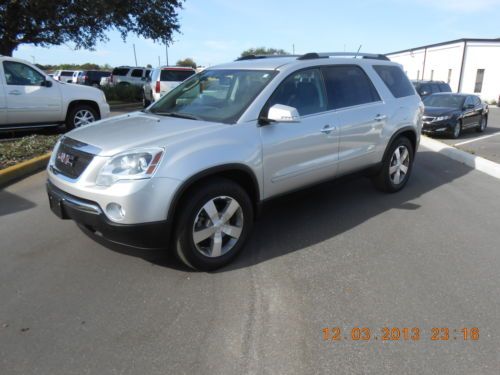Service All Wheel Drive System Gmc Acadia

The dreaded "Service All Wheel Drive System" message on your GMC Acadia's dashboard – it's enough to make any owner's heart sink. But before you panic, let's break down what this message means, common causes, and how to address it effectively. This article is aimed at helping Acadia owners, automotive enthusiasts, and even seasoned mechanics understand this complex system.
Understanding the Acadia's All-Wheel Drive System
The GMC Acadia, particularly models from the late 2000s through the present day, typically features an electronically controlled all-wheel-drive (AWD) system. Unlike a traditional four-wheel-drive system designed for serious off-roading, the Acadia's AWD is primarily intended to improve traction in slippery conditions, such as snow, ice, or rain. The system automatically distributes torque between the front and rear axles as needed, enhancing stability and control.
At the heart of the system is a transfer case, which splits power from the transmission to the front and rear drive shafts. An electronic control unit (ECU) monitors various sensors, including wheel speed sensors, throttle position, and steering angle, to determine the optimal torque distribution. This sophisticated system ensures power is directed to the wheels with the most grip, preventing wheel spin and maximizing traction.
Common Causes of the "Service All Wheel Drive System" Message
Several factors can trigger the "Service All Wheel Drive System" message. Here are some of the most common culprits:
- Faulty Wheel Speed Sensors: These sensors are crucial for monitoring wheel speed and providing data to the ECU. A malfunctioning sensor can disrupt the AWD system's ability to accurately distribute torque, triggering the warning.
- Transfer Case Issues: The transfer case itself can experience problems, such as worn-out clutches, damaged gears, or low fluid levels. These issues can impede the transfer of power to the rear axle.
- ECU Malfunction: Although less common, a problem with the ECU itself can lead to inaccurate readings or incorrect commands to the AWD system.
- Wiring Problems: Damaged or corroded wiring harnesses can interrupt the communication between sensors, actuators, and the ECU.
- Differential Issues: The front and rear differentials can experience wear and tear over time, potentially causing issues that trigger the warning.
Diagnosing the Problem
When the "Service All Wheel Drive System" message appears, it's crucial to diagnose the problem accurately. Here's a step-by-step approach:
- Scan for Diagnostic Trouble Codes (DTCs): Using an OBD-II scanner, read the DTCs stored in the vehicle's computer. These codes can provide valuable clues about the specific component or system that is malfunctioning. Common codes related to AWD issues include those pertaining to wheel speed sensors, the transfer case, or the ECU.
- Inspect Wheel Speed Sensors: Visually inspect the wheel speed sensors and their wiring for any signs of damage or corrosion. Use a multimeter to test the sensors' resistance and output.
- Check Transfer Case Fluid Level and Condition: Ensure the transfer case fluid is at the correct level and is clean. Low or contaminated fluid can lead to transfer case damage.
- Inspect Wiring and Connectors: Carefully examine the wiring harnesses and connectors associated with the AWD system for any signs of damage, corrosion, or loose connections.
- Test the Transfer Case Motor: The transfer case motor engages and disengages the AWD system. Testing the motor can help determine if it is functioning correctly.
Repair and Maintenance
The repair strategy depends heavily on the diagnosis. Here are some common solutions:
- Wheel Speed Sensor Replacement: Replacing a faulty wheel speed sensor is usually a straightforward process.
- Transfer Case Service or Replacement: If the transfer case is damaged, it may need to be rebuilt or replaced. Regular fluid changes can help extend the life of the transfer case. Using the correct transfer case fluid is also extremely important.
- Wiring Repair: Repairing damaged wiring can involve splicing wires, replacing connectors, or replacing entire wiring harnesses.
- ECU Reprogramming or Replacement: In rare cases, the ECU may need to be reprogrammed or replaced. This typically requires specialized equipment and expertise.
Preventative maintenance is key to avoiding AWD system problems. Regularly inspect and maintain the system's components, including the transfer case fluid, wheel speed sensors, and wiring. Adhering to the manufacturer's recommended maintenance schedule can significantly reduce the risk of future issues.
Real-World Examples and Costs
For example, a common repair involves replacing a faulty wheel speed sensor, which can cost between $150 and $300, including parts and labor. A more extensive repair, such as replacing the transfer case, can range from $1,500 to $3,000. Keep in mind that these are just estimates, and the actual cost can vary depending on the specific repair, location, and labor rates.
Conclusion: Addressing the "Service All Wheel Drive System" message requires a methodical approach. By understanding the system, diagnosing the problem accurately, and performing the necessary repairs, you can ensure your GMC Acadia's AWD system continues to provide reliable traction and performance.
